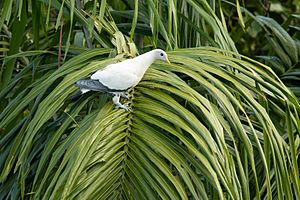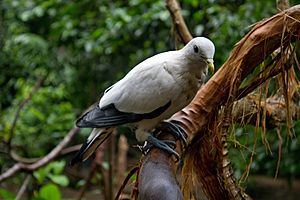Torresian imperial pigeon facts for kids
Quick facts for kids Torresian imperial pigeon |
|
|---|---|
 |
|
| Conservation status | |
| Scientific classification | |
| Genus: |
Ducula
|
| Species: |
spilorrhoa
|
The Torresian imperial pigeon (Ducula spilorrhoa) is a large, striking bird. It's also known by other names like the nutmeg pigeon or white nutmeg pigeon. This pigeon is "pied," meaning it has two distinct colors, mostly white with black parts.
You can find these pigeons in many places, including forests, woodlands, and even mangrove swamps. They live in northern Australia (like Queensland and the Torres Strait Islands), New Guinea, and other nearby islands. Most of these pigeons stay in one place, but the ones in Queensland fly to New Guinea during February to April and return from July to August.
Contents
What Does the Torresian Imperial Pigeon Look Like?

The Torresian imperial pigeon is a big, plump bird. It measures about 38 to 44 centimetres (15 to 17.5 inches) long. Its wingspan can reach about 45 centimetres (18 inches).
Most of its body is white or a pale cream color. However, its flight feathers (the long feathers on its wings) and part of its tail are black. It also has black spots under its tail. Sometimes, its head might look a bit brown because of the fruit it eats!
How Do Torresian Imperial Pigeons Behave?
These pigeons are fast flyers. Their flight is straight and strong, with regular wing beats. Sometimes, they give their wings a sharp flick, which is common for pigeons.
Reproduction and Life Cycle
Male Torresian imperial pigeons perform a special flight to attract a mate. They fly straight up, pause in the air, then tip forward and glide back down.
The female builds a simple nest out of sticks, usually in a tree like a Coconut palm. She lays just one white egg. This egg hatches in about 26 to 28 days. The baby pigeon, called a squab, is ready to fly after about three more weeks.
In Australia, these birds breed between August and January. They often choose offshore islands, building nests in mangroves or palm fronds. Pigeons living in northeast Queensland fly daily from these islands to the mainland rainforests to find food. They return to the islands as the sun sets.
What Do Torresian Imperial Pigeons Eat?
These pigeons are tree-dwelling birds, meaning they spend most of their time in trees. They eat almost only fruit. They can swallow fruits with very large seeds. After they digest the fruit pulp, they either spit out the seeds or pass them whole. This helps spread seeds and grow new plants!
What Sounds Do They Make?
The calls of the Torresian imperial pigeon are deep and distinct. They make sounds like "mrrrooooo," "roo-ca-hoo," and "up-ooooo."
Understanding Their Family Tree

The way scientists classify these pigeons can be a bit confusing. Sometimes, the Torresian imperial pigeon is thought to be a type of pied imperial pigeon. However, many scientists now see it as its own separate species.
There are also different ideas about how many types (subspecies) of Torresian imperial pigeons exist. Some recognize two main types, while others think they are all the same. Scientists continue to study these birds to understand their family tree better.
Are Torresian Imperial Pigeons Safe?
In the past, there were huge groups of these birds in places like Cairns, Australia. People like Edmund Banfield wrote in 1908 about "100,000" birds flying in and out of Dunk Island every day. Harold Frith described these flights as "one of the great ornithological experiences of the tropics."
However, in the 1800s and early 1900s, many of these birds were hunted. People saw them as pests or easy targets for fun. This caused their numbers to drop very quickly. Luckily, conservationists like Margaret and Arthur Thorsborne worked hard to protect them and track their populations.
Today, the population of Torresian imperial pigeons is slowly growing because they are now protected in Australia. It's estimated there are about 30,000 of them. Because they are still fairly common in many areas, organizations like BirdLife International and IUCN consider them a species of "least concern." This means they are not currently at risk of disappearing.
See also
 In Spanish: Dúcula australiana para niños
In Spanish: Dúcula australiana para niños



